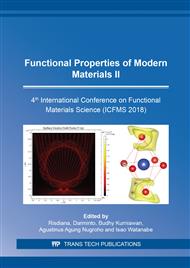[1]
L. M. Falicov, D. T. Pierce, S. D. Bader, R. Gronsky, K. B. Hathaway, H. J. Hopster, D. N. Lambeth, S. S. P. Parkin, G. Prinz, M. Salamon, I. K. Schuller, and R. H. Victora, Surface, Interface, and Thin-Film Magnetism, J. Mater. Res., 5 (1990) 1299.
DOI: 10.1557/jmr.1990.1299
Google Scholar
[2]
H. Hayashi H and Y. Hakuta, Hydrothermal Synthesis of Metal Oxide Nanoparticles in Supercritical Water, Materials 3 (2010) 3794-3817.
DOI: 10.3390/ma3073794
Google Scholar
[3]
T. Saragi, A.S. Santika, B. Permana, N. Syakir, M. Kartawidjaja and Risdiana, Synthesis and Properties of Iron Oxide Particles Prepared by Hidrothermal Method, IOP Conf. Series: Materials Science and Engineering 196 (2017) 012025.
DOI: 10.1088/1757-899x/196/1/012025
Google Scholar
[4]
S.E. Shirsath, M.L. Mane, Y. Yasukawa, X. Liu, M. Akimitsu, Self-Ignited High Temperature Synthesis and Enhanced Super-Exchange Interactions of Ho3+–Mn2+–Fe3+–O2− Ferromagnetic Nanoparticles, J Nanopart Res. 15 (2013) (1976).
DOI: 10.1039/c3cp54257b
Google Scholar
[5]
T. Saragi, N. Syakir, T. H. Nainggolan, C. Alboin and Risdiana, The Effect of Molar Composition of Co2+ to Structure and Magnetic Properties of CoFe2O4, AIP Conf. Proc. 1554 (2013) 123-125.
DOI: 10.1063/1.4820300
Google Scholar
[6]
H.E. Ghandoor, H.M. Zidan, M.M.H. Khalil and M.I.M. Ismail, Synthesis and Some Physical Properties of Magnetite (Fe3O4) Nanoparticles, Int. J. Electrochem. Sci. 7 (2012) 5734-5745.
Google Scholar
[7]
T. Saragi, L.D. Busrifa, S. Butarbutar, B. Permana, and Risdiana, The Impact of Synthesis Temperature on Magnetite Nanoparticles Size Synthesized by Co-precipitation Method, IOP Conf. Series: J. Phys.: Conf. Ser. 1013 (2018) 012190-4.
DOI: 10.1088/1742-6596/1013/1/012190
Google Scholar
[8]
T. Saragi, B. Permana, M. Safitri, L.D. Busrifa, S.W. Butarbutar, L. Safriani, I. Rahayu, and Risdiana, The Effect of pH and Sintering Treatment on Magnetic Nanoparticles Ferrite Based Synthesized by Coprecipitation Method, J. Phys.: Conf. Ser. 1080 (2018) 012019-23.
DOI: 10.1088/1742-6596/1080/1/012019
Google Scholar
[9]
I. Kazeminezhad and S. Mosivand, Phase Transition of Electrooxidized Fe3O4 to g and a-Fe2O3 Nanoparticles Using Sintering Treatment, Acta Physica Polonica A. 125 (2014) 1210.
DOI: 10.12693/aphyspola.125.1210
Google Scholar


